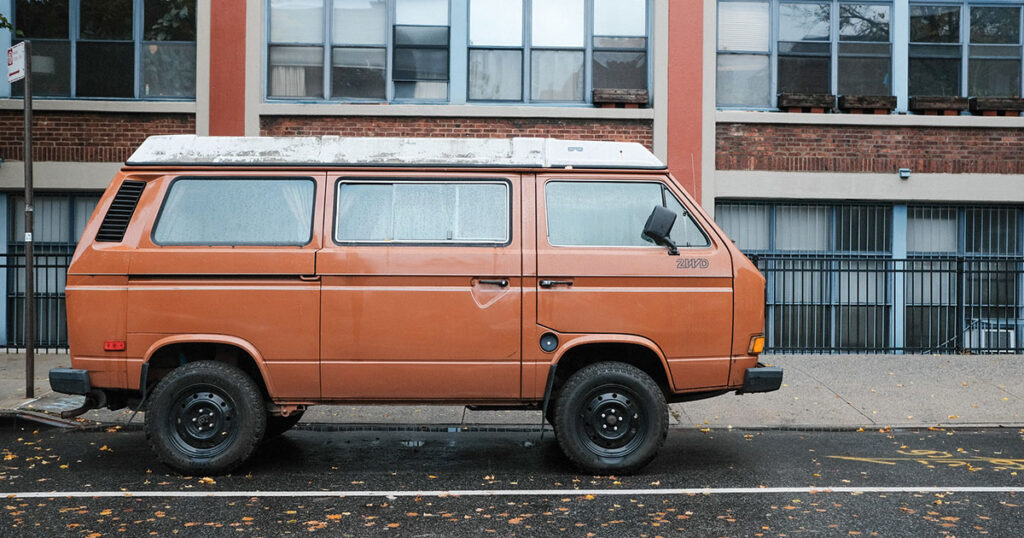
After the pandemic, which in Spain led to an immediate three-month house confinement, weekend cottages on a parcel of land were in high demand. So were camping vans. Where before you’d hardly noticed any at all, you now saw them everywhere, and VW vans were the ones most in evidence, both the kind that came factory-fitted for camping, and the utility vans that could be turned into campers for much less money. To convert a utility van into a camper, you could buy one of the many kits available online and do the work yourself, or you could take your van to a garage specializing in making and installing to-order inserts. It was the second possibility that a friend of mine with a new VW Caravelle was leaning toward. I went along one morning when he visited a business making customized models, from basic to luxury. The business was set up in a corner of an enormous garage specializing in farm machinery, and the man in charge of the new sideline was Miguel, the son of the garage owner. When we arrived, we saw a young man we guessed to be Miguel in the glassed-in office, busy with a customer, and so we waited in the foyer.
When the young man stepped out with his client, he greeted us and said if we’d give him a minute to finish with the client, he’d be right with us. It was exactly the kind of greeting you’d expect in that situation, but within the standard phrasing is lots of room for variation in delivery. This fellow’s manner hit the middle ground between officious and ingratiating, a good place. He seemed to be in his mid or late 20s, and was neither tall nor short, not muscular but not frail, and not handsome but nice enough looking. He wore a black hoodie and his left arm was in a sling, a glove on that hand. When he returned to us, I noticed that the whole arm, shoulder down, seemed thin. The glove he wore was loose over his hand, which appeared shrunken, like his arm. He had a long, wide scar on his neck, five inches of it in view before it disappeared inside his collar. It seemed likely there was a connection between the scar and the arm. Was there a connection too between the damaged limb and his highly confident manner?
We spent about 45 minutes with Miguel, talking about options, costs, materials, and principles of construction. Particle board was no good, plywood was fine. A sink and plastic water reservoir with a pump and a spray attachment on a hose were cheap and easy, and if you wanted hot water, you could either use the fuel for the van or an electric heater running off an extra car battery. A stove with a gas line was asking for trouble, but a gas camping stove was easy, cheap, and safe. I nodded at everything he said. After we left, I turned to my friend and commented that the guy impressed me as knowledgeable and forthright, and my friend agreed. He’d as good as decided to give Miguel the job.
“I wonder what happened to his arm,” I said as we drove away, back along the coast toward Gijón. I often felt I needed a third hand for manual tasks, but I believed Miguel would have no trouble with just one hand. He had operated his phone perfectly, cradling it against the injured left arm and using his right hand to work it. “Did you notice the scar?” I inquired, but my friend hadn’t.
“Would you rather lose an arm or a leg?” I next asked.
“An arm, don’t you think?” my friend said, and I agreed, even though I use my legs only for getting from one spot to another, whereas I use my arms and hands all the time. So why my answer? Because I had watched Miguel manipulate handles, drawers, loose hardware, and his phone, all with no difficulty. I had viewed the enormous panel van he had fetched from the Netherlands and was converting into a camping van for himself and his girlfriend. One-armed work didn’t seem impossible. It didn’t even appear difficult. In high school, I knew a student who had a hook for a hand. He liked to surprise new acquaintances by holding out his hook to shake. Until he did, often these people did not even know that he was missing a hand. Once, at an airport coffee shop, I’d stood in line with a man who had two hooks, yet managed to carry away his coffee with no difficulty. In contrast, although many people adapt beautifully to a prosthetic leg, I have never encountered such a person. And without witnessing someone else rise to the challenge, I doubted I would be able to myself. Cut off my leg, and I’ll collapse. Cut off my arm, and I’ll summon thoughts of Miguel. Including the puzzle of how he drove his new van from the Netherlands all the way to Spain with one working hand and the other tucked inside a sling against his chest. How indeed! Though he has essentially only one arm, he did not bring the van home single-handedly, but with his girlfriend—his other right hand. Maybe even his better right hand.

